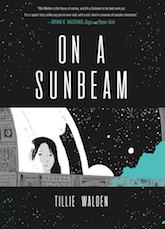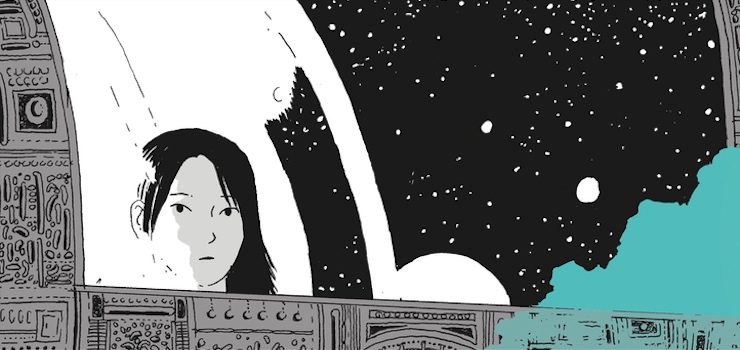Originally published as a webcomic (2016-2017), Tillie Walden’s On a Sunbeam is a fantastical queer coming of age tale. The dual narrative follows Mia across two significant portions of her life, first during her freshman year at the boarding school where she meets Grace, and second, five years later, when she begins her first adult job out of school. She joins a crew who reclaim and restore architecture across the reaches of space: Alma and Char, who are married, as well as Jules and Elliot who are closer in age to Mia. There’s more to the friendly ship’s crew than Mia would’ve guessed at first, though, and a surprising shared history leads their new-made family down a risky but important path.
The chapters alternate in time, developing young Mia’s relationship with Grace while simultaneously exploring her relationship with the crew and, in the end, bringing those two threads together. With as much reflection as it has action, On a Sunbeam takes the reader on a quiet, thoughtful journey through all different shades of love as well as the risks worth taking for it. It’s a meditative and domestic project, human above all even while showing people’s rough edges.
(Some spoilers below.)
Walden has in the past noted that she is inspired by, among other things, the movies of Studio Ghibli and the surrealism of Murakami. These influences undergird the imagery and emotional resonance of On a Sunbeam as well, particularly visible in the book’s liminal occupation of multiple genre categories, its focus on families and relationships, and the narrative significance it places on mundane moments of life. Above all the resonance comes from the comic’s dreamlike quality: ships shaped like beta fish that swim through the currents of outer space and boarding schools with assembly halls whose glass paneling looks out into a sweeping reach of stars; even the magical logic of Jules’ encounter with a spiritual creature in The Staircase is half dream and half narrative.
That magic-realist approach is present through the project as a whole. Nothing is explained; the social and cultural milieu of the text is given on faith or as an obvious fact. For example, On a Sunbeam’s universe appears to be entirely inhabited by women. Elliot identifies as genderfluid and uses neutral pronouns—implying that a concept of different gender categories exists and has concrete enough poles to require noting fluidity—but is also misgendered “she” at one point in the text. Other than Elliot, the characters are entirely women and occupy a variety of roles and relations: wives, girlfriends, sisters, mothers, aunts, caretakers, bosses, teachers, athletes, bullies, friends, family. Walden’s choice to make this a fact of the world without explanation or exploration renders it fascinatingly, delightfully invisible. Queerness is therefore also unremarkable. In the boarding school, Grace and Mia are bullied briefly but not for their relationship. Race is also unremarked upon in the world but visible to the reader, as both of our main characters, Grace and Char are both women of color.
The boarding school portion of the narrative builds slowly as Grace and Mia fall for one another, have their first sexual experience together, and navigate the politics of teachers and classmates as passionate, often-willful children. Contrasted with the Mia of young adulthood—five years older and wiser, working in a physical labor role, learning to open up to her found family—the high school Mia is a bit of a terror. However, it’s that contrast that allows the reader to build a sense of real, contemplative understanding with Mia. When she decides to reveal that Grace is from The Staircase and she wants to undertake a forbidden expedition to at least have her chance to say goodbye, she’s taking a risk.
But her chosen family is supportive. We learn that Alma and Char used to be illegal travelers and were the ones who, years before, picked up Grace to take her to the boarding school in the first place. Elliot is from The Staircase and has their own reason to avoid returning, but is willing to do so for Mia. The shift to action for the final portion of the book feels more dangerous, the consequences more serious, as a result of the softness and methodical mundanity of the preceding chapters. Walden demonstrates that it is possible to tell a warm, tender story about building relationships, growing up, and being a better person while maintaining suspense and tension as well. The dramatic conflicts and escapes of the climactic chapter are emotionally intense because the danger feels thoroughly real.
Buy the Book


On A Sunbeam
In narrative terms, the plot beats Walden hits aren’t breaking much ground. The reading experience is a bit more like shrugging on a well-worn familiar coat, nothing unexpected or provocative, and the book falls firmly into the category of “this is what you’d expect.” What On a Sunbeam ultimately has to offer is thematic, its soft exploration of human attachment. For example, Mia does find Grace… but when she does she explicitly notes that it’s been five years and they were children back then. They’re not in love anymore, nor would she presume to know Grace more than she does, but she wants a chance. That subversion alone was delightful. In addition, we also have Alma and Char deciding to retire together; we have Elliot coming to terms with the loss of their parental figure and the violence they’re capable of in connection; we have Jules in all her boundless enthusiasm being the one person able to tame a great spirit because of her dedicated but carefree attitude. Jules and Alma fight, but their relationship is stone serious. Elliot communicates nonverbally and builds an intimate, trusting friendship with Mia—to the point where the only words they speak in the entire comic are to her, hidden from the reader by a trick of the page.
And that brings me to the art, which is simply gorgeous. Walden works in sweeping rushes of blue and white on black—so much black space dotted with stars—and then abrupt bursts of green, orange, yellow, red that shock the heart into beating faster. Her line art is at once simple and complex. Human faces and figures are rendered with broad strokes that are immediately recognizable, while architecture, plants, and creatures often have staggering detail and the aforementioned bursts of color. The influence of Ghibli is once again a direct comparison to make and a pleasurable one. Walden focuses on the mundane details of bedrooms, on strange games that feel like magic but must be science or both. She renders just enough to make her world feel intimate and present while leaving a great deal to the imagination on the larger scale. You can almost feel the wind blowing in some scenes.
The scope is grand but the tale itself is personal, much like the art and panel arrangement. The choice to be open, to be radically kind, to listen and share and be vulnerable, comes up again and again in this comic. When characters refuse, they suffer; when they concede and do the work of bonding, the work of building relationships or at least understanding, they succeed. The metaphor of their profession, repairing collapsing structures back to handsomeness and utility, is fairly direct. Self-determination, social responsibility, and community are the building blocks of love and adult maturity. It’s a willfully tender message that is reflected at all levels of the comic, one I found heartwarming—a pause of sorts, a hopeful breather, that allows a measure of light to shine into the world.
On a Sunbeam is available from First Second.
Read an excerpt here.
Lee Mandelo is a writer, critic, and editor whose primary fields of interest are speculative fiction and queer literature, especially when the two coincide. They have two books out, Beyond Binary: Genderqueer and Sexually Fluid Speculative Fiction and We Wuz Pushed: On Joanna Russ and Radical Truth-telling, and in the past have edited for publications like Strange Horizons Magazine. Other work has been featured in magazines such as Stone Telling, Clarkesworld, Apex, and Ideomancer.










